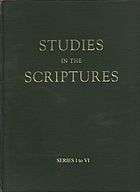Studies in the Scriptures

Studies in the Scriptures is a series of publications, intended as a Bible study aid, containing seven volumes of great importance to the history of the Bible Student movement, and the early history of Jehovah's Witnesses.
Origin
The author of Studies in the Scriptures, Charles Taze Russell, reported that he did not write them "through visions and dreams, nor by God's audible voice," but that he sought "to bring together these long scattered fragments of truth".[1] The first volume was written in 1886. Originally titled The Plan of the Ages as part of a series called Millennial Dawn, it was later renamed The Divine Plan of the Ages. The name of the series was changed to Studies in the Scriptures in 1904 in order to clarify their nature as biblical textbooks.
Purpose
The series was written as a Bible study aid. The intention was that by studying the Bible topically, rather than verse by verse, details of God's purpose might become clearer. The series progresses from elementary topics, such as the existence of God and promoting the Bible as God's word, to deeper subject matter throughout the series.
| Part of a series onBible Students | |
| Communities | |
| Free Bible Students | |
| Laymen's Home Missionary Movement | |
| Publishing houses | |
| Dawn Bible Students Association | |
| Pastoral Bible Institute | |
| Publications | |
|---|---|
| The Dawn·The New Creation Frank and Ernest (broadcast) Studies in the Scriptures The Photo-Drama of Creation | |
| Biographies | |
| Charles Taze Russell Jonas Wendell · William Henry Conley Nelson H. Barbour · Paul S. L. Johnson A. H. Macmillan · J. F. Rutherford Conrad C. Binkele | |
| Beliefs | |
| Jehovah · Nontrinitarianism · Atonement Dispensationalism · Sheol and Hades Resurrection · Annihilationism | |
Contents
- The Divine Plan of the Ages (1886)—elementary topics and attempts to show God has a clear purpose for mankind;
- The Time is at Hand (1889)—an interpretation of biblical chronology, keys to time prophecies, the second advent of Christ, and the identification of the Antichrist;
- Thy Kingdom Come (1891)—describes biblical prophecies in further detail, along with the fate of Israel and information on the Great Pyramid of Giza as being built under God's direction. The section on Pyramidology was influenced by the theories of Charles Piazzi Smyth, who also helped review it;
- The Day of Vengeance (1897), later renamed The Battle of Armageddon—suggests causes of the dissolution of the present order, with the biblical remedy as God's kingdom;
- The At-one-ment Between God and Men (1899)—discusses the nature of humanity, the work of redemption, and the Holy Spirit;
- The New Creation (1904)—discusses the seven days of creation found in Genesis, and the duties and personal responsibilities of a Christians.
Viewpoint and theology
The series was criticized by some early 20th century ministers as an attempt to replace the Bible. Russell's view was that whilst the Bible had been studied by different methods, topical study was the best approach. In addition to other material, the six volumes contain commentary about biblical events and expressions. Russell did not claim infallibility, but declared that God's plan of salvation could not be understood independently from his writings. He stated, "if he then lays [the Studies in the Scriptures] aside and ignores them and goes to the Bible alone, though he has understood his Bible for ten years, our experience shows that within two years he goes into darkness."[2] Studies in the Scriptures claimed to represent that humankind had reached the end of the current era, and that Jesus would soon separate the wheat from the weeds.
The Finished Mystery
Following Russell's death in 1916, a seventh volume—entitled The Finished Mystery—was published in 1917 and advertised as his "posthumous work".[3] This seventh volume was a detailed interpretation of the book of Book of Revelation, but also included interpretations of Ezekiel and the Song of Solomon. An advertisement for the book in Zion's Watch Tower called it "the true interpretation",[4] and it was promoted as being "of the Lord—prepared under his guidance."[5]
Immediate controversy surrounded both its publication and content. It was soon established that it was largely written and compiled by two of Russell's associates, Clayton J. Woodworth and George H. Fisher, and edited by Russell's successor, Joseph Franklin Rutherford.[6]
Withdrawal
The abandonment of several core doctrines under Rutherford's presidency prompted the Watch Tower Society to cease publication of all seven volumes of Studies in the Scriptures in 1927, although the books were still being sold door-to-door in 1929.[7][8] Other publications of Jehovah's Witnesses, including Jehovah's Witnesses—Proclaimers of God's Kingdom (their official history) and Revelation—Its Grand Climax at Hand (their exposition of the Book of Revelation) make reference to Studies in the Scriptures.
The six original volumes of Studies in the Scriptures are still published by the Bible Student movement.
References
- ↑ Zion's Watch Tower: 87. April 1, 1899. Missing or empty
|title=(help) - ↑ Zion's Watch Tower: 297. September 15, 1910. Missing or empty
|title=(help) - ↑ The Finished Mystery. p. preface, p. 5.
This book may properly be said to be a posthumous publication of Pastor Russell.
- ↑ (The Finished Mystery, 1917, p. 334)
- ↑ (The Finished Mystery, 1917, p. 126)
- ↑ Wills, Tony (2006). A People For His Name. p. 97.
- ↑ "The Modern Fulfillment of the "Penny"". The Watchtower: 54. January 15, 1967.
But in 1927 The Finished Mystery and the other six volumes of the Studies in the Scriptures ceased to be published
- ↑ The Watchtower. October 15, 1929. Missing or empty
|title=(help)
External links
- Studies in the Scriptures Online
- Studies in the Scriptures and other materials from Biblestudents.com
- Searchable database of all Pastor Russell's writings
- On-line copy of Volume 7, The Finished Mystery